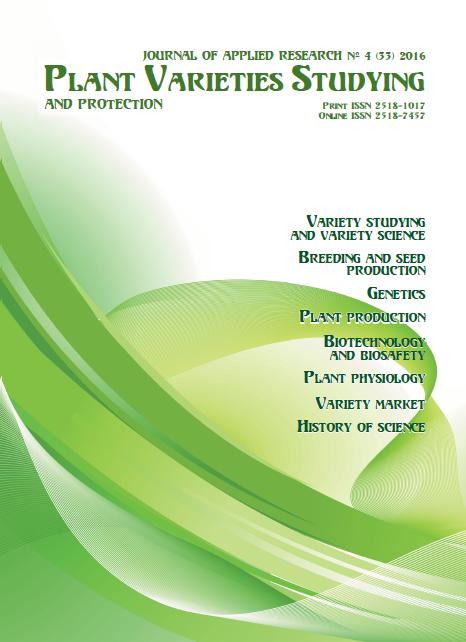Impact of weather conditions during the growing season on winter barley yield in the Forest-Steppe zone of Ukraine
DOI:
https://doi.org/10.21498/2518-1017.4(33).2016.88670Keywords:
winter barley, yield, weather conditions, growing season, amount of precipitation, air temperature, the sum of the degree daysAbstract
Purpose. To establish the level of formation of winter barley yield depending on weather conditions during the growing season in the Forest-Steppe zone of Ukraine.
Methods. Field investigations, ANOVA, variance and correlation analysis.
Results. Positive correlation was revealed between yield and the duration of the vegetation (r = 0.54) and especially “heading–maturation” period (r = 0.76). Moderate positive correlation was established between yield and mean daily air temperature during the period from termination to resumption of vegetation (r = 0.44), and strong negative one – between yield and mean daily air temperature during heading to maturation period (r = -0.77). Positive correlation was observed between yield and rainfall amount during the period from vegetation resumption to heading (r = 0.30). In general, during the growing season the correlation was weak (r = 0.16). For the period of “heading–maturation” low negative value (r = -0.11) was fixed. This was due to heavy precipitations, especially torrential rains, which in some years have caused lodging of plantings resulted in yield decrease.
Conclusions. Under the conditions of Forest-Steppe zone of Ukraine, fluctuations in temperature and water regimes are responsible for significant variability in growing season duration and yield of winter barley. Optimal amount of precipitation (close to long-time annual average) and their uniform distribution throughout growing season is the most favorable for obtaining high yield. “Heading–maturation» period is responsible for the formation of winter barley yield level.
Downloads
References
Posivni ploshchi silskohospodarskykh kultur pid urozhai 2014 roku: Statystychnyi biuleten [Area under crops for the harvest of 2014. Statistical bulletin]. (2014). Kyiv: N.p. [in Ukrainian]
Gudzenko, V. M. (2014). Evaluation of winter barley breeding lines for productivity and adaptability under conditions of the Forest-Steppe zone of Ukraine. Selektsia i Nasinnitstvo [Plant Breeding and Seed Production], 106, 13–23. [in Ukrainian]
Zhuchenko, A. A. (1990). Adaptivnoe rastenievodstvo: ekologo-geneticheskie osnovy [Adaptive plant-growing: genetic and ecological basic principles]. Kishinev: Shtiintsa. [in Russian]
Shevchenko, S. N. (2006). Selektsiya yarovogo yachmenya i pshenitsy dlya usloviy Srednego Povolzh’ya [Spring barley and wheat breeding for the Middle Volga region] (Extended abstract of Doc. Agric. Sci. Diss.). N. M. Tulaikov Samara Research Institute of Agriculture, Penza, Russia. [in Russian]
Rainer, L., Steinberger, I., & Deeke, U. (1980). Ozimyy yachmen [Winter barley]. (V. I. Ponomarev, Trans.). Moscow: Kolos. [in Russian]
Volkodav, V. V. (Ed.). (2003). Method of examination and state testing of varieties of grain, cereal and leguminous crops. Okhorona prav na sorty roslyn [Plant variety rights protection] (Vol. 2, Part. 3). Kyiv: Alefa. [in Ukrainian]
Dospekhov, B. A. (1985). Metodika polevogo opyta (s osnovami statisticheskoy obrabotki rezul’tatov issledovaniy) [Methods of field experiment (with the basics of statistical processing of research results)]. (5th ed., rev.). Moscow: Agropromizdat. [in Russian]
Mavi, H. S., & Tupper, G. J. (2004). Agrometeorology. Principles and applications of climate studies in agriculture. New York: The Haworth Press, Inc.
Sadras, V. O., & Calderini, D. L. (Eds.). (2009). Crop physiology. Applications for genetic improvement and agronomy. Burlington, MA, USA: Elsevier/Academic Press.
Blum, A. (2011). Plant breeding for water-limited environments. New York: Springer-Verlag.
Ehlers, W., & Goss, M. (Eds.). (2003). Water dynamics in plant production. Wallingford, UK: CABI Publishing.
Downloads
Published
How to Cite
Issue
Section
License
Copyright (c) 2016 Ukrainian Institute for Plant Variety Examination

This work is licensed under a Creative Commons Attribution-ShareAlike 4.0 International License.
Starting in 2022, the copyright to the publication remains with the authors
Our journal abides by the CREATIVE COMMONS copyright rights and permissions for open access journals.
Authors, who are published in this journal, agree to the following conditions:
- The authors reserve the right to authorship of the work and pass the first publication right of this work to the journal under the terms of a Creative Commons Attribution License, which allows others to freely distribute the published research with the obligatory reference to the authors of the original work and the first publication of the work in this journal.
- The authors have the right to conclude separate supplement agreements that relate to non-exclusive work distribution in the form in which it has been published by the journal (for example, to upload the work to the online storage of the journal or publish it as part of a monograph), provided that the reference to the first publication of the work in this journal is included.

























 Ukrainian Institute for Plant Varieties Examination
Ukrainian Institute for Plant Varieties Examination  Селекційно-генетичний інститут
Селекційно-генетичний інститут Institute of Plant Physiology and Genetics of the National Academy of Sciences of Ukraine
Institute of Plant Physiology and Genetics of the National Academy of Sciences of Ukraine
 The National Academy of Agrarian Sciences of Ukraine
The National Academy of Agrarian Sciences of Ukraine